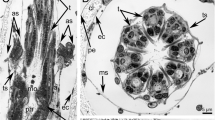Summary
Electron microscopic investigations on the eye of Ceratophyllus prove that its construction does not match any type of ommatidia as yet described in insects.
The perceiving part of the eye consists of more than I00 retinula cells (in the hedgehog flea more than 300). They form a bulky central rhabdom. Cross-sections of the rhabdom reveal ligaments forming irregular patterns. The central rhabdom is surrounded by numerous smaller rhabdoms (or rhabdomeres), collectively described as a lateral rhabdom.
At the distal end the lateral and central rhabdoms are connected; towards the basis they part, and further proximally, the lateral rhabdom assumes the position of the central rhabdom. However, in Archaeopsylla only a central rhabdom occurs. The axons are surrounded by a neural lamina, and vary in diameter. They leave the retinular area in smaller or larger groups, but soon merge to form a homogeneous nerve.
The cuticula part of the eye consists of a thick biconvex corneal lens completely smooth on its surface and of a cup projecting deeply into the head. Proximally, the cup has a eccentric opening through which pass axons, trachooles and hemolymph. Cup and lens are lined with small epithelial cells. Neither cristal cone nor as pigment cells are present.
Zusammenfassung
Elektronenmikroskopische Untersuchungen am Auge von Ceratophyllus zeigen, daß es keinem der bislang beschriebenen Ommatiden-Bautypen bei Insekten zuzuordnen ist.
Der Rezeptorteil des Auges besteht aus über 100 Retinulazellen. (Beim Igelfloh Archaeopsylla sind es sogar über 300.) Diese bilden im Zentrum ein sehr voluminöses Rhabdom. Auf Querschnitten ist dieses aus Bändern geformt, die unregelmäßige Muster bilden. Außerdem liegen um dieses zentrale Rhabdom herum noch zahlreiche kleinere Rhabdomere bzw. Rhabdome. In ihrer Gesamtheit sollen sic als laterales Rhabdom bezeichnet werden. Distal ist es mit dem zentralen verbunden, basalwärts trennt es sich von diesem, um dann noch weiter proximal dessen zentrale Position einzunchmen. Beim Igelfloh dagegen ist nur ein Zentralrhabdom ausgebildet.
Die von einer Neurallamelle umgebenen Axone sind von unterschiedlicher Dicke. Sic verlassen den Bereich der Sehzellen in kleineren oder größeren Gruppen, treten jedoch schon nach einer kurzen Strecke zu einem einheitlichen Nerven zusammen.
Der cuticulare Teil des Auges besteht aus einer dicken, bikonvexen, außen völlig glatten Cornealinse und einem tief in das Innere des Kopfes hineinragenden Becher. Dieser besitzt proximal eine exzentrisch liegende Öffnung für die Axone, Tracheolen und die Lymphe. Becher und Linse werden von schmalen Epithelzellen ausgekleidet. Ein Kristallkegel ist nicht vorhanden. Schirmpigmenthaltige Zellen fehlen eben-falls.
Similar content being viewed by others
Literatur
Bahr, R.: Die Ultrastruktur der Photorezeptoren von Lithobius forficatus L. (Chilopoda: Lithobiidae). Z. Zellforsch. 116, 70–93 (1971).
Hanstrom, B.: Das Gehirn und die Sinnesorgane der Aphanipteren. Entom. Tidskrift 48, 154–160 (1927).
Link, E.: Über die Stirnaugen der hemimetabolen Insekten. Zool. Jb. Abt. Anat. u. Ontog. 27, 281–376 (1909).
Perrelet, A.: The fine structure of the retina of the honey bee drone. Z. Zellforsch. 108, 530–562 (1970).
Rösch, P.: Beitrage zur Kenntnis der Entwicklungsgeschichte der Strepsipteren. Jena. Z. 50, 1–50 (1913).
Skrzipek, K.-H., Skrzipek, H.: Die Morphologie der Bienenretina (Apis mellifica L. ô) in elektronenmikroskopischer und lichtmikroskopischer Sicht. Z. Zellforsch. 119, 552–576 (1971).
Wachmann, E.: Zum Feinbau des Komplexauges von Stylops spec. (Insecta, Strepsiptera). Z. Zellforsch. 123, 411–424 (1972).
Wenk, P.: Der Kopf von Ctenocephalus canis (Curt.) (Aphaniptera). Zool. Jb. Abt. Anat. u. Ontog. 73, 103–164 (1953).
Author information
Authors and Affiliations
Rights and permissions
About this article
Cite this article
Wachmann, E. Das auge des hühnerflohs Ceratophyllus gallinae (Schrank) (Insecta, siphonaptera). Z. Morph. Tiere 73, 315–324 (1972). https://doi.org/10.1007/BF00391926
Received:
Issue Date:
DOI: https://doi.org/10.1007/BF00391926




